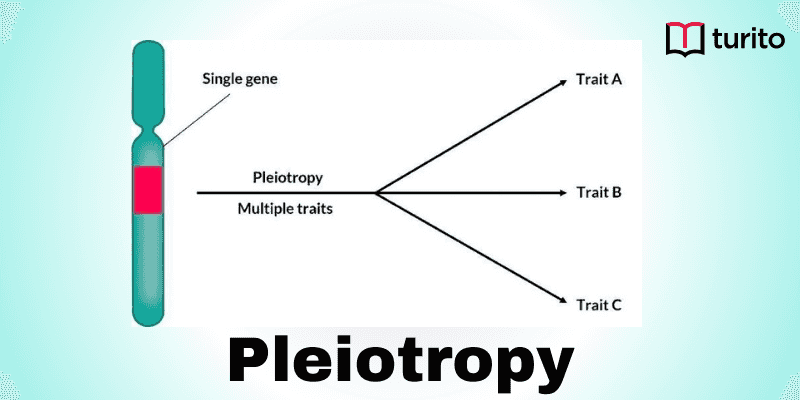Pleiotropy

 Introduction
Introduction
When Mendel was studying inheritance in pea plant, he made several interesting observations regarding the color of various components of the plant. Specifically, Mendel observed that plants with colored seed coats always had colored flowers and colored leaf axils.
He also noticed that pea plants which had colorless seed coats always had white flowers and lacked pigmentation on their axils. In other words, seed coat color was always associated with specific flower and axil colors in Mendel’s pea plants.
Today, we know that Mendel’s observations resulted from pleiotropy.
Pleiotropy is a condition wherein a single gene contributes to multiple phenotypic traits.
In this case, not only the seed coat color gene was responsible for seed coat color but also for flower color and pigmentation of the axil.
 Explanation
Explanation
Pleiotropy:
The term “pleiotropy” is derived from the two Greek words pleio meaning “many” and tropic meaning “affecting.”
Genes that affect multiple (although unrelated) phenotypes are thus called pleiotropic genes.
Pleiotropy can also be defined as a mutation in one single gene that cause a disease with a wide range of symptoms. It has been observed in a wide range of species, even humans.

However, we must not confuse pleiotropy with polygenic traits. In polygenic traits, multiple genes work together convergently to result in a single phenotype.
Pigmentation of the skin is an example of a polygenic trait as it is controlled by multiple genes.
Examples of pleiotropy:
Fruit flies and the vestigial gene:
In the fruit fly drosophila, the vestigial genes play a very critical role in the development of the wing.
As a direct result, these flies develop short wings and are unable to fly in an appropriate way if they are homozygous for the recessive form of the vestigial gene (vg). Along with regulating wing development, the vestigial gene is also pleiotropic.
Indirectly, the gene alters the number of egg strings in a fly’s ovaries, alters the position of bristles on a fly’s scutellum, and decreases the length of a fly’s life.

Pigmentation and deafness in cats:
Approximately 40% of cats with white fur and blue eyes are found to be deaf. An initial hint at the link between pigmentation and deafness was the observation that white cats that have one blue eye and one yellow eye were deaf only on the blue-eyed side.
Interestingly, this phenomenon is not only seen in cats; for example, the Waardenburg syndrome is a disorder that acts in a similar way in humans.
As the gene responsible for both of these phenotypes affects pigmentation as well as the ability to hear, the gene is pleiotropic.
Researchers continued to understand how hearing capacity and the process of pigmentation were correlated. For instance, in mice, experiments involving pigment cells have shown that pigmentation plays an important role in maintaining the fluid in the ear canals.
Animals that lack the pigment also lack the ear canal fluid, which causes the ear canal to collapse. In turn, this collapse continues to degeneration of the auditory nerves, which results in deafness.
Examples of pleiotropy in humans:
Marfan syndrome:
There are a lot of examples of pleiotropic genes in humans, some of which are associated with diseases.
For example, the inherited disorder that results in connectivity issues in the tissues, i.e., the Marfan syndrome. This type of syndrome mostly affects the eyes, heart, skeleton, and blood vessels. Marfan syndrome is a disorder in humans in which a single gene is responsible for a series of symptoms, which include thinness, joint hypermobility, limb elongation, lens dislocation and increased susceptibility to heart disease.

Phenylketonuria:
One of the most widely utilized examples of pleiotropy in humans is phenylketonuria (PKU). This disorder is caused due to the deficiency of enzyme phenylalanine hydroxylase. This enzyme is important to convert the essential amino acid phenylalanine to tyrosine.
A defect in a single gene that codes for this enzyme, therefore, results in the multiple phenotypes that are associated with PKU. These include mental retardation, eczema and pigment defects that make individuals lighter-skinned.
The most common PKU is called classic PKU, which typically affects newborns.

Antagonistic pleiotropy:
The concept of antagonistic pleiotropy is central to the theory of aging proposed by American biologist G.C. Williams in 1957.
Antagonistic pleiotropy is when one gene control more than one trait. At least one of these traits is advantageous to the organism’s fitness early on in life and at least one is harmful to the organism’s fitness later on due to a decline in the force of natural selection.
For example, in humans, the p53 gene signals damaged cells to stop reproducing, thereby resulting in cell death. This gene helps prevent cancer by preventing cells with DNA damage from dividing, but it also suppresses the division of stem cells, which allows the body to renew and replace deteriorating tissues during ageing.
As a result, this situation is an example of antagonistic pleiotropy, in which the expression of a single gene leads to competing effects, some of which are beneficial to the organism’s fitness and some of which are harmful.
Summary
- Pleiotropy is a condition wherein a single gene contributes to multiple phenotypic traits.
- The term “pleiotropy” is derived from the two Greek words pleio meaning “many” and
tropic meaning “affecting.” - Pleiotropy can also be defined as: when a mutation in one single gene cause a disease with a wide range of symptoms, this situation is known is pleiotropy, and it has been observed in a wide range of species, even humans.
- The concept of antagonistic pleiotropy is central to the theory of aging proposed by American biologist G.C. Williams in 1957.
- Antagonistic pleiotropy is when one gene control more than one trait. At least one of these traits is advantageous to the organism’s fitness early on in life and at least one is harmful to the organism’s fitness later due to a decline in the force of natural selection.

Related topics
Mutation Theory of Evolution and Types
Introduction: Cell is the basic unit of living organisms from bacteria to humans all are made up of cells, which contain a nucleus and the nucleus contain DNA Explanation: Mutations is a sudden changes in chromosomal DNA., They cover only those changes that alter the chemical structure of the gene at the molecular level. These […]
Read More >>Lamarckism: Postulates and Drawbacks
Introduction: Evolution states that distinct types of plants, animals, and other living organisms on Earth have their origin in pre-existing life forms. It is a variation in the inherited characteristics (traits) of biological populations over successive generations. These traits are the expressions of genes that are passed on from parents to offspring in the course […]
Read More >>Biodiversity: Classification of Living Organisms
Introduction to Biodiversity: Fig No.1 Biodiversity Classification Fig No.2 Different organisms The Characteristics of Living Organisms Fig No. 3 Classification Diversity in Living Organisms The Five Kingdom Classification The five kingdoms in this widely accepted classification are made up of species with similar growth and functioning characteristics. Organisms are classified into five kingdoms based on […]
Read More >>Mitochondria – The power House of a Cell
The Cell Organelles – Mitochondria Introduction: Powerhouse Of Cell Mitochondria are primarily responsible for converting nutrients into energy. They yield ATP molecules to fuel cell activities. As they do aerobic respiration, mitochondria are often referred to as the powerhouse of the cell. There are three stages of aerobic respiration. Those three stages are: Origin Of […]
Read More >>Other topics







Comments: